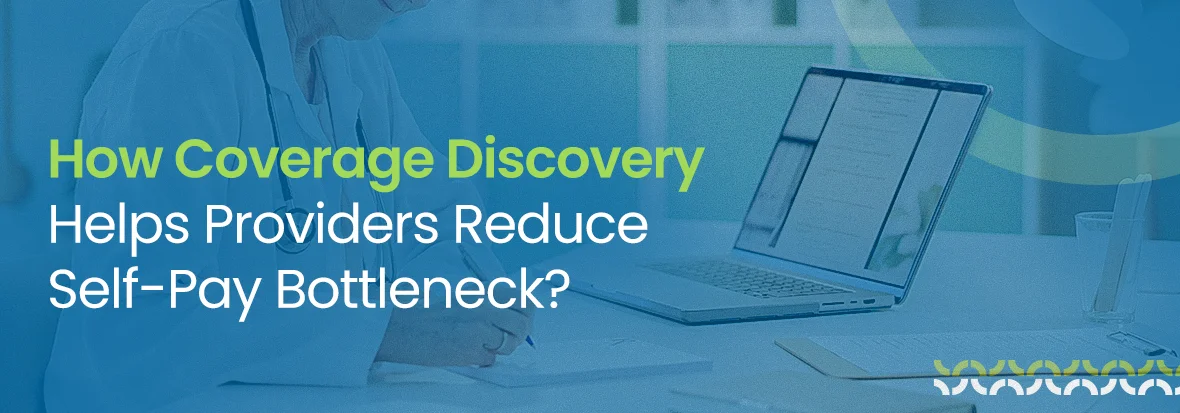Every provider dreads the moment a patient is marked as “self-pay.” It slows down payments, increases collection costs, and often leads to unpaid balances. In fact, self-pay accounts are one of the biggest bottlenecks in healthcare revenue cycles today.
But what if many of these balances never had to be self-pay in the first place? Patients often have hidden or secondary insurance coverage they forget to mention, or they may not even know they qualify for certain benefits. When that coverage goes undiscovered, providers lose revenue and patients face unnecessary financial stress. This is why coverage discovery is important. In this guide, we’ll explain what coverage discovery means, why self-pay creates bottlenecks, how it works, and the steps providers can take to use it effectively.
What does Coverage Discovery Mean?
Coverage discovery is the process of identifying a patient’s active insurance coverage that was not shared, not known, or not verified at the time of service. Many patients are registered as “self-pay” either because they forget to provide insurance details, are unaware of secondary coverage, or believe they don’t have insurance at all.
Instead of writing off these visits as self-pay, coverage discovery utilizes technology and payer databases to search for hidden or secondary insurance plans. A patient may qualify for Medicaid, have a new employer’s plan, or be covered under a spouse’s insurance. Automated checks across payers help providers find valid coverage and turn self-pay balances into reimbursable claims.
In simple words, coverage discovery helps providers capture revenue, ease patients’ financial load, and ensure fair payment for care.
Why Self-Pay Is a Bottleneck for Providers
When patients are listed as self-pay, providers face many hurdles. These challenges go beyond money. They also take up staff time, reduce patient satisfaction, and disrupt daily workflow.
Delayed or Lost Revenue
Self-pay accounts often result in slow or incomplete payments. Many patients cannot cover large balances, which leads to partial payments or none at all.
Higher Collection Costs
Collecting from patients is more expensive than billing insurance. Staff spend more time sending statements, following up with phone calls, or setting up payment plans. In many cases, the cost of chasing payments outweighs what is collected.
Increased Write-Offs
When balances stay unpaid too long, practices must write them off. These losses cut revenue and make financial planning harder.
Administrative Strain
Billing teams handle extra work for self-pay patients, like calls and bill explanations. This slows other tasks like claim follow-ups and denial management.
Patient Frustration
Large medical bills can overwhelm patients. This often causes frustration and lowers satisfaction, making them less likely to return.
In short, self-pay accounts hurt cash flow, add staff workload, and create stress for both providers and patients.
Are you tired of chasing self-pay balances?
How Does Insurance Discovery Typically Work?
Coverage discovery uses both technology and payer networks to search for active insurance when a patient is marked as self-pay. The process is usually automated, but can also involve manual checks by billing staff. Here’s how it works in practice:
Step 1: Flagging the Self-Pay Account
When a patient is listed as self-pay at registration or after a denied claims recovery, the account is flagged for review.
Step 2: Running Eligibility Searches
Specialized tools connect with national and regional payer databases. These systems verify active coverage under Medicaid, Medicare, or other insurance.
Step 3: Matching Patient Information
The system checks details like name, birth date, SSN, or address against payer records. Even if patients don’t mention a plan, the search can still uncover it.
Step 4: Verifying Active Coverage
Once coverage is found, the billing team checks if it is active and what it covers. This prevents providers from sending claims to inactive plans.
Step 5: Updating the Claim
The patient’s account is updated with the discovered insurance information, and a corrected claim is submitted for payment.
Through these steps, a “self-pay” balance can be turned into a reimbursable claim, reducing provider write-offs and patient stress.
How Coverage Discovery Benefits The Providers?
Coverage discovery directly improves both the financial and operational health of a practice. By uncovering hidden or missed insurance coverage, providers can shift balances away from self-pay and into reimbursable claims. Here are the main benefits:
Stronger Cash Flow
Instead of waiting for patients to pay large balances, providers receive payments from insurance companies, which are more reliable and faster.
Fewer Write-Offs
Every discovered insurance plan means one less account going to bad debt or being written off. This protects the bottom line and reduces revenue leakage.
Lower Collection Burden
Staff spend less time chasing payments. They can focus on core tasks like denial management and claims follow-up.
Improved Patient Relationships
Patients feel relieved when insurance covers their care instead of large out-of-pocket bills. This improves satisfaction and loyalty.
Better Compliance and Accuracy
Coverage discovery tools often integrate with Eligibility verification healthcare systems. This helps providers submit clean claims from the start, reducing denials tied to missing or incorrect coverage.
Coverage discovery takes a major financial pressure point, which is self-pay. It turns this situation into an opportunity to secure timely reimbursement while building trust with patients.
How Providers Can Implement Coverage Discovery in Their Practice?
Putting coverage discovery into practice doesn’t have to be overwhelming. Providers can take simple steps to make it a valuable part of the revenue cycle.
Measure Your Self-Pay Burden
Start by reviewing how many accounts each month are labeled as self-pay. This baseline will help you see the impact once coverage discovery is in place.
Select the Right Tool or Partner
Coverage discovery can be done with in-house software or outsourced partners. Small practices may gain more from outsourcing, while larger groups may prefer adding a tool to their practice management system.
Define When to Run Discovery
Decide at what points you will check for hidden coverage. Many practices do this at registration, before sending patient statements, and after initial claim denials. Building this into the workflow avoids missed opportunities.
Standardize Staff Roles
Assign clear responsibilities. Front-desk staff may verify coverage during registration, while billing teams update claims once coverage is found. Everyone should know when it’s their turn to act.
Train and Educate
Train staff on reading results, fixing records, and resubmitting claims. Well-trained teams make fewer errors and speed reimbursement.
Track and Report Results
Monitor how many self-pay accounts are converted to insured claims each month, how much revenue is recovered, and how much patient balance is reduced. These metrics will show the real financial benefit of coverage discovery.
By following these steps, providers can turn self-pay from a dead end into a chance to capture revenue.
Get the Insurance Discovery feature build into your workflow?
Conclusion
Self-pay slows providers down. But it does not have to stay that way. Coverage discovery gives you a clear path to find hidden insurance and reduce unpaid balances.
The important step is to make it part of your daily routine. Check accounts, use the right tools, and train your team. Small, steady changes bring lasting results.
In the end, coverage discovery is not just about money. It makes billing smoother for you and less stressful for your patients.

